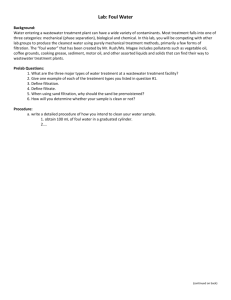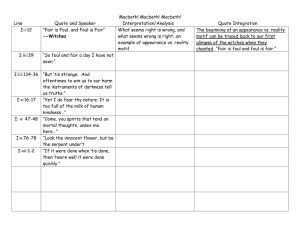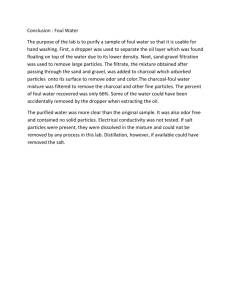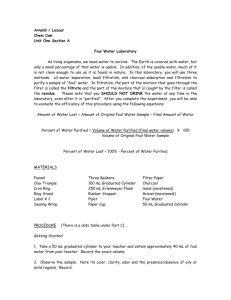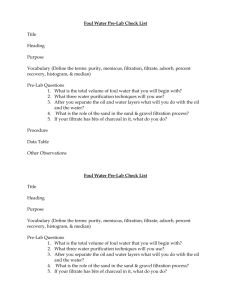File - E
advertisement
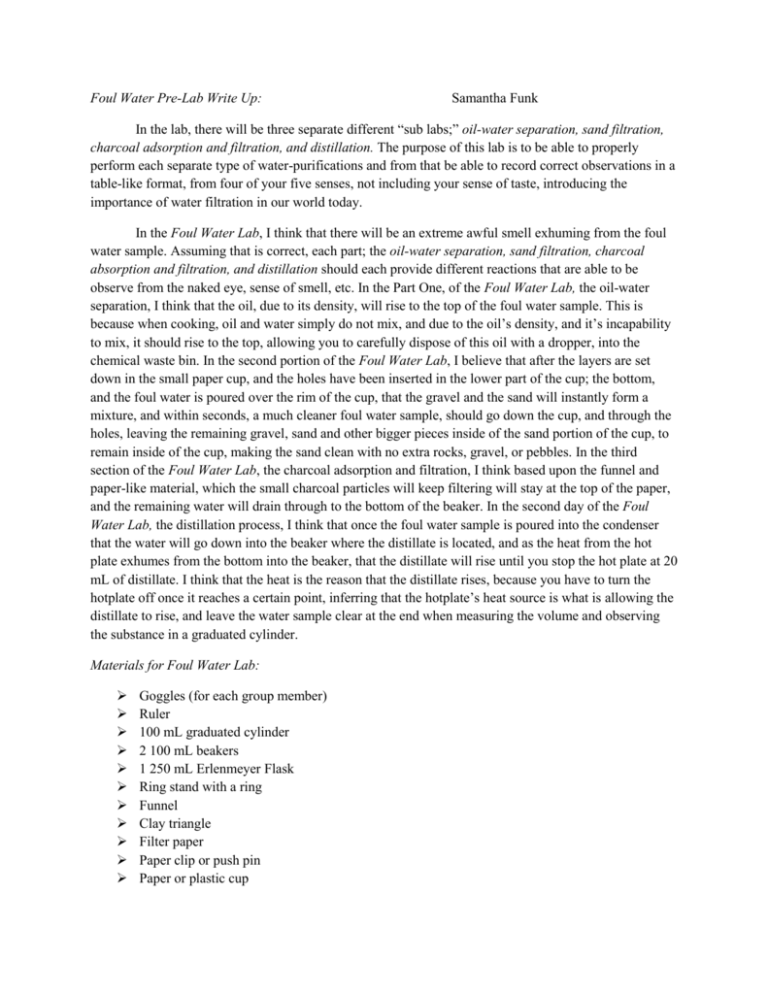
Foul Water Pre-Lab Write Up: Samantha Funk In the lab, there will be three separate different “sub labs;” oil-water separation, sand filtration, charcoal adsorption and filtration, and distillation. The purpose of this lab is to be able to properly perform each separate type of water-purifications and from that be able to record correct observations in a table-like format, from four of your five senses, not including your sense of taste, introducing the importance of water filtration in our world today. In the Foul Water Lab, I think that there will be an extreme awful smell exhuming from the foul water sample. Assuming that is correct, each part; the oil-water separation, sand filtration, charcoal absorption and filtration, and distillation should each provide different reactions that are able to be observe from the naked eye, sense of smell, etc. In the Part One, of the Foul Water Lab, the oil-water separation, I think that the oil, due to its density, will rise to the top of the foul water sample. This is because when cooking, oil and water simply do not mix, and due to the oil’s density, and it’s incapability to mix, it should rise to the top, allowing you to carefully dispose of this oil with a dropper, into the chemical waste bin. In the second portion of the Foul Water Lab, I believe that after the layers are set down in the small paper cup, and the holes have been inserted in the lower part of the cup; the bottom, and the foul water is poured over the rim of the cup, that the gravel and the sand will instantly form a mixture, and within seconds, a much cleaner foul water sample, should go down the cup, and through the holes, leaving the remaining gravel, sand and other bigger pieces inside of the sand portion of the cup, to remain inside of the cup, making the sand clean with no extra rocks, gravel, or pebbles. In the third section of the Foul Water Lab, the charcoal adsorption and filtration, I think based upon the funnel and paper-like material, which the small charcoal particles will keep filtering will stay at the top of the paper, and the remaining water will drain through to the bottom of the beaker. In the second day of the Foul Water Lab, the distillation process, I think that once the foul water sample is poured into the condenser that the water will go down into the beaker where the distillate is located, and as the heat from the hot plate exhumes from the bottom into the beaker, that the distillate will rise until you stop the hot plate at 20 mL of distillate. I think that the heat is the reason that the distillate rises, because you have to turn the hotplate off once it reaches a certain point, inferring that the hotplate’s heat source is what is allowing the distillate to rise, and leave the water sample clear at the end when measuring the volume and observing the substance in a graduated cylinder. Materials for Foul Water Lab: Goggles (for each group member) Ruler 100 mL graduated cylinder 2 100 mL beakers 1 250 mL Erlenmeyer Flask Ring stand with a ring Funnel Clay triangle Filter paper Paper clip or push pin Paper or plastic cup Dropper Conductivity Tester Lab Apron (optional) Day 2; water sample from day before 100 mL graduated cylinder 2 100 mL beakers Conductivity tester Distillation apparatus Procedure: i. ii. iii. iv. v. vi. vii. viii. ix. x. xi. xii. xiii. Read through the entire lab, and go through all safety concerns before beginning the Foul Water Lab. Gather all of your materials needed for the experiment, including the foul water sample which you will ask to get from Mr. Gransee. Once you have gotten the foul water sample, make sure to find all of the measurements needed to find the volume of the water and calculate the volume with the graduated cylinder and record your final answer. Correctly pour the foul water sample that you have just gotten and calculated the volume of, and observe the general appearance of the substance and record your results. After you have finished that section of the lab, carefully grab the electrical conductivity tester, and figure out whether the foul water sample conducts electricity, or does not conduct electricity. Then move on to the oil-water portion of the Foul Water Lab. Make sure you have gathered all of your materials needed to complete the oil-water separation section of the Foul Water Lab, and then let the foul water sample to sit inside of the beaker for one to two minutes. This is where you will see if any oily substances are a part of the sample. Then, using a dropper, carefully remove any of the oily substance found in the foul water sample, and dispose of it in the chemical waste bin. Make sure that you have a clean graduated cylinder, and put the water from the beaker into the cylinder and record the properties observed from the water sample into your lab group’s table. Make sure that you have gathered all of the materials needed for the second part of the lab, the sand filtration, and poke several holes in the bottom of the cup. When proceeding, take the ruler needed for the lab, and measure into the cup one cm of gravel, followed by two cm of sand, and finally by another cm of gravel. Then, place your sand filter on top of the 100 mL beaker, and gently pour the foul water sample through the filter, allowing the filtered water to remain in the beaker. Observe and record the new state of the foul water sample. Make sure that you have gathered all of your materials for the third part of the lab, the charcoal adsorption and filtration, including the 250 mL Erlenmeyer flask, and add in a small spoonful of charcoal. Proceed by adding in the foul water sample into the flask and quickly stir the flask from 20 to 30 seconds. xiv. xv. xvi. xvii. xviii. xix. xx. xxi. xxii. xxiii. xxiv. xxv. xxvi. xxvii. Then take the filter paper, fold it in half, and in half again, until it creates one layer on one side, and three layers on the other side, and dampen the filter paper, and gently place it into the funnel cone. Carefully support the funnel cone inside of the ring clamp, and lower that clamp so that the stem of the funnel extends a few centimeters inside of the 100 mL beaker. Then properly pour the foul water sample with the charcoal into the filter so that it does not overflow, or go in between the funnel cone and the filter. Observe the new properties of the water sample, measure it’s volume in a clean graduated cylinder, and record your results in your table. Dispose of all substances and materials properly; the used charcoal from the third section of the experiment in a container provided by Mr. Gransee (Chemical Waste Bin?) and pour your new water sample into a clean 100 mL beaker and label it with your group members’ names’ and class period and set them in the area directed, then wash all the glassware used, put back materials, clean your work space, and wash hands before going on to your next period. Before continuing in day two’s portion of the lab, make sure you re read through the lab, and go over the section you are about to begin, grab new materials needed make sure you have answered all of the questions from the previous day’s work. Make sure that you properly set up the distillation apparatus with all of the essentials and make sure everything is tightened properly so there are no leaks. Grab your sample from yesterday’s work and pour it into the flask portion of the apparatus, and make sure that the stoppers on both ends of the glass tubing are set up appropriately, and ask Mr. Gransee to check your work before proceeding. Once he has given you permission to proceed, put the clean 100 mL beaker at the end of the condenser so that it collects the distillate. Double check to make sure that everyone’s goggles are securely fastened, and turn on the water to exhume from the condenser, and the hot plate to give off heat to the flask. Without allowing this liquid to boil, keep the heat on until there has been 20 mL of distillate collected. Turn off the heat and make sure everything has been cooled completely. Observe the properties of your water sample in a graduated cylinder for the last time, and record it in your table. Proceed by cleaning up your station according to Mr. Gransee’s direction. Safety Concerns: Make sure that your entire group is wearing goggles throughout the entire experiment do to the using of the chemicals in the experiment, and do not taste any of the substances/foul water samples at any point in the lab. In the distillation portion of the lab, be sure to keep your hands away from the hot plate until completely cool, do avoid getting burned. If you don’t dispose of the chemicals properly in the lab, or some gets on any portion of your body, make sure to clean your station correctly, and wash any area of skin exposed to the chemicals thoroughly.

